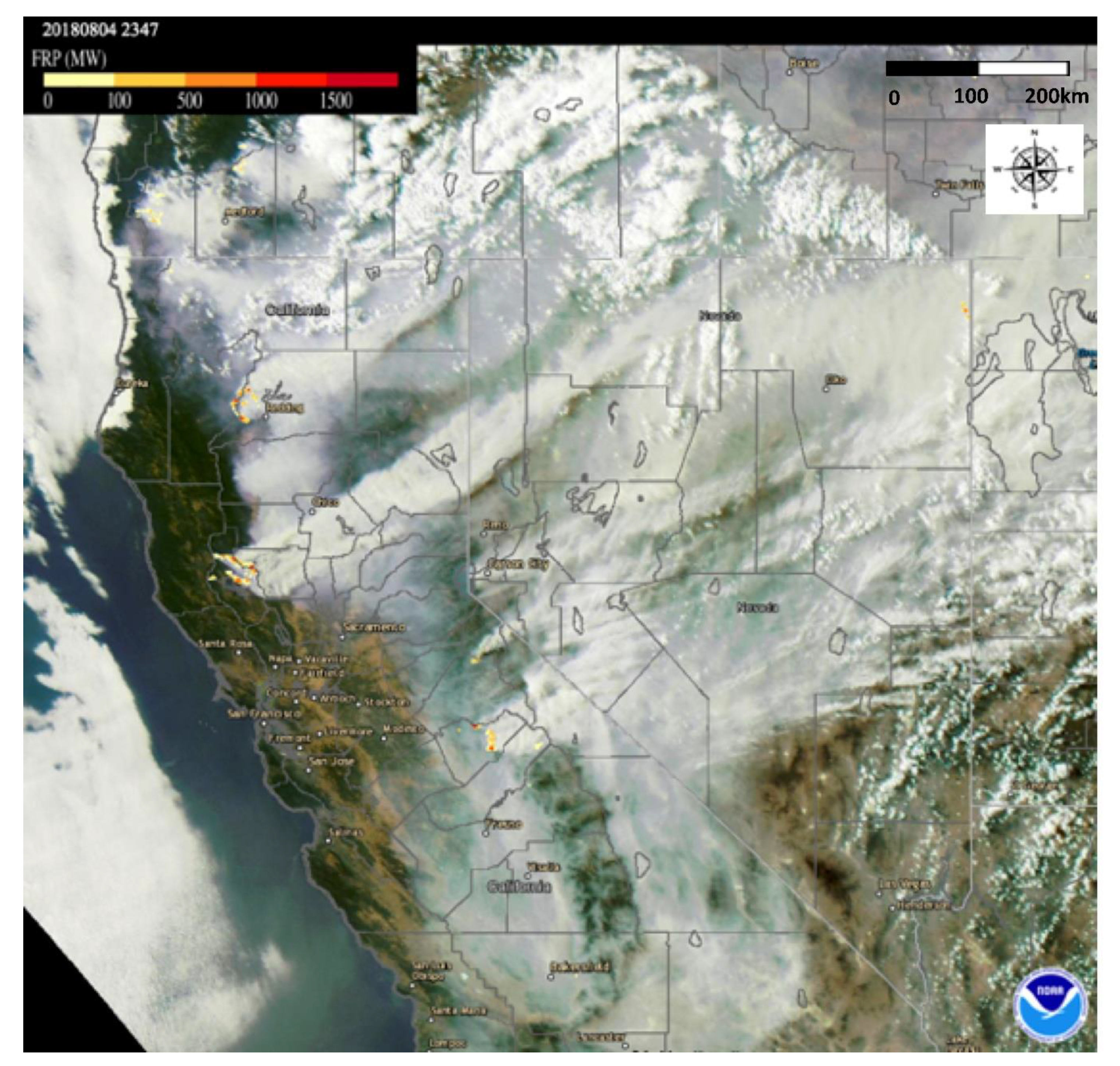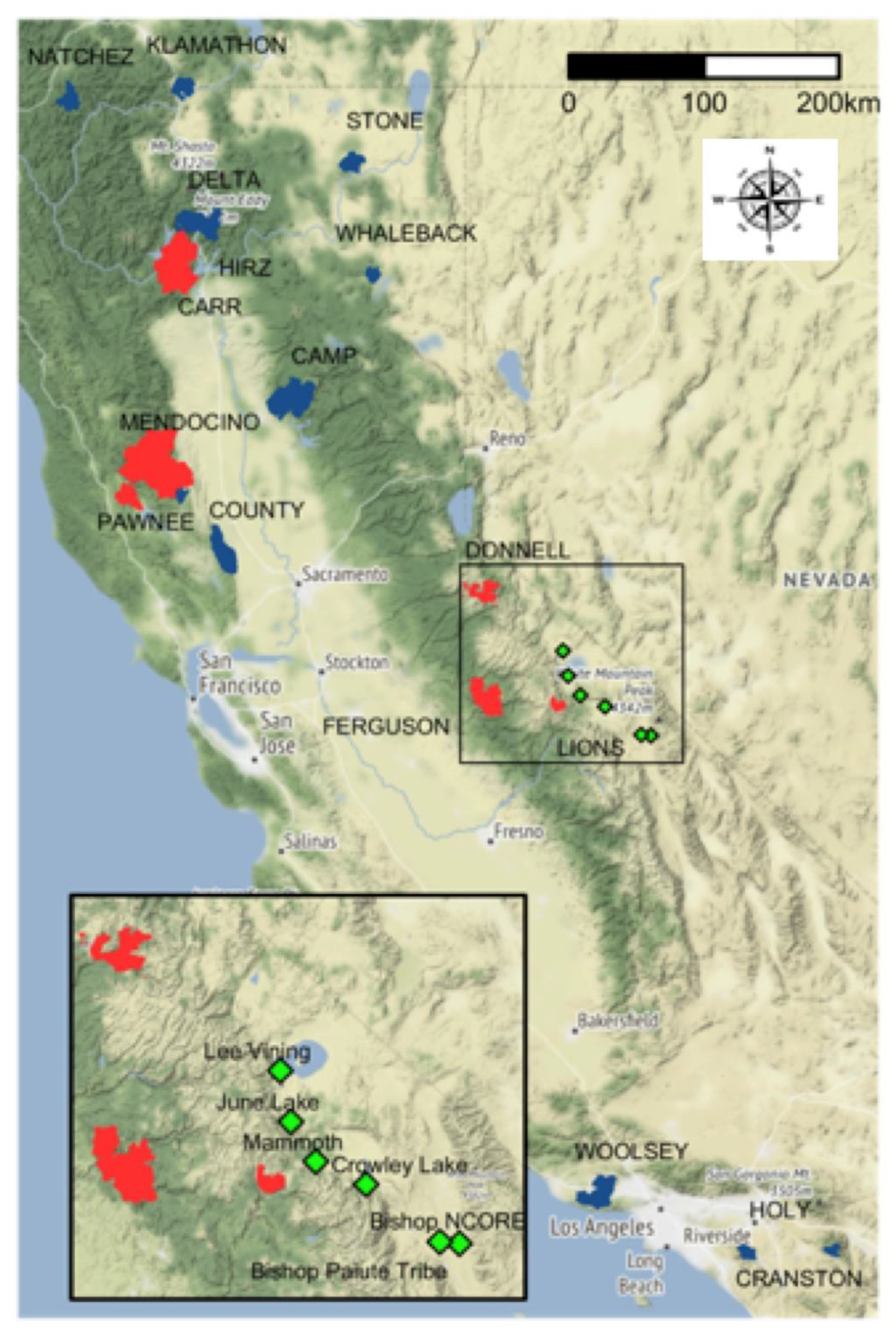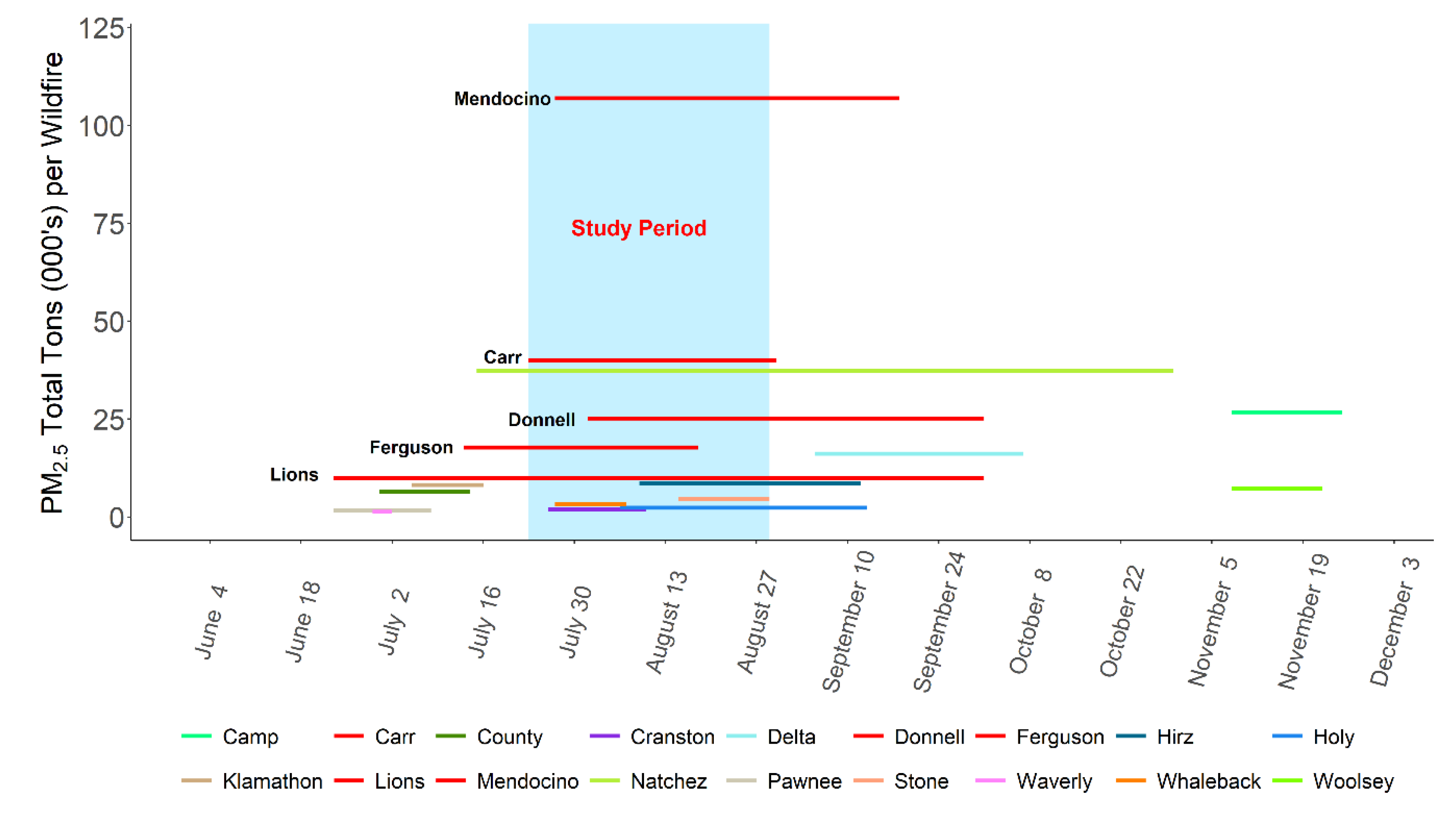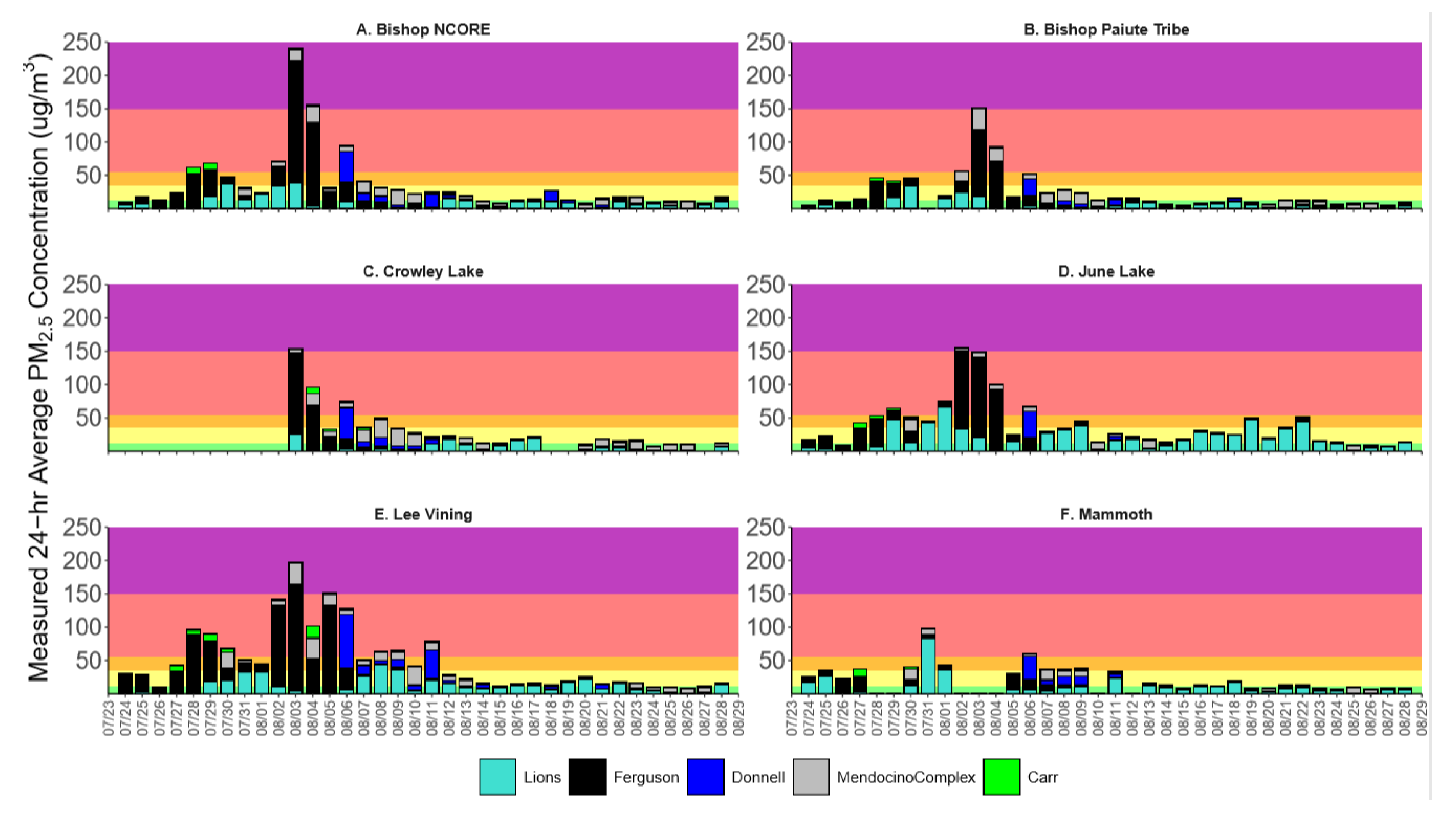Apportioning Smoke Impacts of 2018 Wildfires on Eastern Sierra Nevada Sites
Abstract
1. Introduction
2. Methods
3. Results
4. Discussion
5. Conclusions
Author Contributions
Funding
Acknowledgments
Conflicts of Interest
References
- Meng, J.; Li, C.; Martin, R.V.; Donkelaar, A.; Hystad, P.; Brauer, M. Estimated long-term (1981–2016) concentrations of ambient fine particulate matter across North America from chemical transport modeling, satellite remote sensing, and ground-based measurements. Environ. Sci. Technol. 2019, 53, 5071–5079. [Google Scholar] [CrossRef] [PubMed]
- McClure, C.D.; Jaffe, D.A. U.S. particulate matter air quality improves except in wildfire-prone areas. Proc. Natl. Acad. Sci. USA 2018, 115, 7901–7906. [Google Scholar] [CrossRef] [PubMed]
- Spracklen, D.V.; Mickley, L.J.; Logan, J.A.; Hudman, R.C.; Yevich, R.; Flannigan, M.D.; Westerling, A.L. Impacts of climate change from 2000 to 2050 on wildfire activity and carbonaceous aerosol concentrations in the western United States. J. Geophys. Res. 2009, 114. [Google Scholar] [CrossRef]
- Westerling, A.L.; Hidalgo, H.G.; Cayan, D.R.; Swetnam, T.W. Warming and Earlier Spring Increase Western U.S. Forest Wildfire Activity. Science 2006, 313, 940–943. [Google Scholar] [CrossRef]
- Naeher, L.P.; Brauer, M.; Lipsett, M.; Zelikoff, J.T.; Simpson, C.D.; Koenig, J.Q.; Smith, K.R. Woodsmoke heath effects: A review. Inhal. Toxicol. 2007, 19, 67–106. [Google Scholar] [CrossRef]
- Barregard, L.; Sällsten, G.; Gustafson, P.; Andersson, L.; Johansson, L.; Basu, S.; Stigendal, L. Experimental exposure to woodsmoke particles in healthy humans: Effects on markers of inflammation, coagulation, and lipid peroxidation. Inhal. Toxicol. 2006, 18, 845–853. [Google Scholar] [CrossRef]
- Keywood, M.D.; Ayers, G.P.; Gras, J.L.; Gillett, R.W.; Cohen, D.D. Size distribution and sources of aerosol in Launceston, Australia, during winter 1997. J. Air Waste Manag. Assoc. 2000, 50, 418–427. [Google Scholar] [CrossRef][Green Version]
- Liu, J.C.; Wilson, A.; Mickley, L.J.; Dominici, F.; Ebisu, K.; Wang, Y.; Sulprizio, M.P.; Peng, R.D.; Yue, X.; Son, J.Y.; et al. Wildfire-specific fine particulate matter and risk of hospital admissions in urban and rural counties. Epidemiology 2017, 28, 77–85. [Google Scholar] [CrossRef]
- Jaffe, D.A.; O’Neill, S.M.; Larkin, N.K.; Holder, A.L.; Peterson, D.L.; Halofsky, J.E.; Rappold, A.G. Wildfire and prescribed burning impacts on air quality in the United States. J. Air Waste Manag. Assoc. 2020, 70, 583–615. [Google Scholar] [CrossRef]
- Reisen, F.; Duran, S.M.; Flannigan, M.; Elliot, C.; Rideout, L. Wildife smoke and public health risk. Int. J. Wildland Fire 2015, 24, 1029–1044. [Google Scholar] [CrossRef]
- North, M.; Stephens, S.; Collins, B.; Agee, J.; Aplet, G.; Franklin, J.; Fulé, P. Reform forest fire management: Agency incentives undermine policy effectiveness. Science 2015, 349, 1280–1281. [Google Scholar] [CrossRef] [PubMed]
- Schweizer, D.; Preisler, H.K.; Cisneros, R. Assessing relative differences in smoke exposure from prescribed, managed, and full suppression wildland fire. Air Qual. Atmos. Health 2018, 12, 87–95. [Google Scholar] [CrossRef]
- Long, J.W.; Tarnay, L.W.; North, M.P. Aligning smoke management with ecological and public health goals. J. For. 2017, 116, 76–86. [Google Scholar] [CrossRef]
- Schwezier, D.; Cisneros, R.; Navarro, K. The effectiveness of adding fire for air quality benefits challenged: A case study of increased fine particulate matter from wilderness fire smoke with more active fire management. For. Ecol. Manag. 2019, 458. [Google Scholar] [CrossRef]
- USEPA. National Ambient Air Quality Standards (40 CFR part 50). Available online: https://www.epa.gov/criteria-air-pollutants/naaqs-table (accessed on 8 May 2020).
- Schwezier, D.; Cisneros, R.; Traina, S.; Ghezzehei, T.A.; Shaw, G. Using National Ambient Air Quality Standards for fine particulate matter to assess regional wildland fire smoke and air quality management. J. Environ. Manag. 2017, 201, 345–356. [Google Scholar] [CrossRef]
- Zhong, S.; Li, J.; Whiteman, C.D.; Bian, X.; Yao, W. Climatology of high wind events in the Owens Valley, California. Mon. Weather Rev. 2008, 136, 3536–3552. [Google Scholar] [CrossRef]
- Fujioka, F.M.; Roads, J.O.; Chen, S.C. Climatology. In Oxidant Air Pollution Impacts in the Montane Forests of Southern California. Ecological Studies (Analysis and Synthesis); Miller, P.R., McBride, J.R., Eds.; Springer: New York, NY, USA, 1999; Volume 134. [Google Scholar] [CrossRef]
- Saide, P.E.; Peterson, D.A.; da Silva, A.; Anderson, B.; Ziemba, L.D.; Diskin, G.; Sachse, G.; Hair, J.; Butler, C.; Fenn, M.; et al. Revealing important nocturnal and day-to-day variations in fire smoke emissions through a multiplatform inversion. Geophys. Res. Lett. 2015, 42, 3609–3618. [Google Scholar] [CrossRef]
- Li, F.; Zhang, X.; Roy, D.; Kondragunta, S. Estimation of biomass-burning emissions by fusing the fire radiative power retrievals from polar-orbiting and geostationary satellites across the conterminous United States. Atmos. Environ. 2019, 211, 274–287. [Google Scholar] [CrossRef]
- Mass, C.F.; Ovens, D. The northern California wildfires of 8–9 October 2017: The role of a major downslope wind event. Bull. Am. Meteor. Soc. 2019, 100, 235–256. [Google Scholar] [CrossRef]
- RStudio Team. RStudio: Integrated Development for R. RStudio; PBC: Boston, MA, USA, 2020; Available online: http://www.rstudio.com/ (accessed on 9 September 2020).
- Callahan, J.; Martin, H.; Pease, S.; Miller, H.; Dingels, Z.; Aras, R.; Hagg, J.; Kim, J.; Thompson, R.; Yang, A. PWFSLSmoke: Utilities for Working with Air Quality Monitoring Data. R Package: Version 1.2.111, 2019. The Comprehensive R Archive Network. Available online: http://cran.r-project.org/web/packages/PWFSLSmoke/index.html (accessed on 20 March 2020).
- O’Neill, S.M.; Raffuse, S. High temporal resolution satellite fire detection data provide important improvements in smoke forecasting for large wildfires. Eos 2020, submitted. [Google Scholar]
- Larkin, N.K.; O’Neill, S.M.; Solomon, R.; Raffuse, S.; Strand, T.; Sullivan, D.C.; Krull, C.; Rorig, M.; Peterson, J.; Ferguson, S.A. The BlueSky smoke modeling framework. Int. J. Wildland Fire 2009, 18, 906–920. [Google Scholar] [CrossRef]
- Ottmar, R.D.; Sandberg, D.V.; Riccardi, C.L.; Prichard, S.J. An overview of the Fuel Characteristic Classification System—Quantifying, classifying, and creating fuelbeds for resource planning. Can. J. For. Res. 2007, 37, 2383–2393. [Google Scholar] [CrossRef]
- Prichard, S.J.; Kennedy, M.C.; Wright, C.S.; Cronan, J.B.; Ottmar, R.D. Predicting forest floor and woody fuel consumption from prescribed burns in southern and western pine ecosystems of the United States. For. Ecol. Manag. 2017, 405, 328–338. [Google Scholar] [CrossRef]
- O’Neill, S.M.; Diao, M.; Raffuse, S.; Wilkins, J.; Al-Hamdan, M.Z.; Freedman, F.; Barik, M.; Jia, Y.; Tong, D.; Zou, Y.; et al. An inter-comparison study on PM2.5 emissions in 2017 northern California wildfires. J. Air Waste Manag. Assoc. 2020, submitted. [Google Scholar]
- Draxler, R.R.; Hess, G.D. An overview of the HYSPLIT_4 modelling system for trajectories, dispersion and deposition. Aust. Met. Mag. 1998, 47, 295–308. [Google Scholar]
- Brown, T.J.; Kahyaoglu-Koracin, J. CANSAC-CEFA Operations and Products for the California and Nevada Smoke and Air Committee. CEFA Report 07-01. 2007. Available online: http://cefa.dri.edu/Publications/publications_home.php (accessed on 27 July 2020).
- Wilkins, J.L.; Pouliot, G.; Foley, K.; Appel, W.; Pierce, T. The impact of US wildland fires on ozone and particulate matter: A comparison of measurements and CMAQ model predictions from 2008 to 2012. Int. J. Wildland Fire 2018, 27, 684–698. [Google Scholar] [CrossRef]
- Zou, Y.; O’Neill, S.M.; Larkin, N.K.; Alvarado, E.C.; Solomon, R.; Mass, C.; Liu, Y.; Odman, M.T.; Shen, H. Machine learning-based integration of high-resolution wildfire smoke simulations and observations for regional health impact assessment. Int. J. Environ. Res. Public Health 2019, 16, 2137. [Google Scholar] [CrossRef] [PubMed]
- Drury, S.A.; Larkin, N.S.; Strand, T.T.; Huang, S.; Strenfel, S.J.; Banwell, E.M.; O’Brien, T.E.; Raffuse, S.M. Intercomparison of fire size, fuel loading, fuel consumption, and smoke emissions estimates on the 2006 Tripod fire, Washington, USA. Fire Ecol. 2014, 10, 56–83. [Google Scholar] [CrossRef]
- Herron-Thorpe, F.L.; Mount, G.H.; Emmons, L.K.; Lamb, B.K.; Jaffe, D.A.; Wigder, N.L.; Chung, S.H.; Zhang, R.; Woelfle, M.D.; Vaughan, J.K. Air quality simulations of wildfires in the Pacific Northwest evaluated with surface and satellite observations during the summers of 2007 and 2008. Atmos. Chem. Phys. 2014, 14, 12533–12551. [Google Scholar] [CrossRef]
- Garcia-Menendez, F.; Hu, Y.T.; Odman, M.T. Simulating smoke transport from wildland fires with a regional-scale air quality model: Sensitivity to uncertain wind fields. J. Geophys. Res. Atmos. 2013, 118, 6493–6504. [Google Scholar] [CrossRef]
- Baker, K.; Woody, M.; Tonnesen, G.; Hutzell, B.; Pye, H.; Beaver, M.; Pouliot, G.; Pierce, T. Contribution of regional-scale fire events to ozone and PM2.5 air quality estimated by photochemical modeling approaches. In Atmospheric Environment; Elsevier Science Ltd.: New York, NY, USA, 2016; Volume 140, pp. 539–554. [Google Scholar]
- Huang, R.; Qin, M.; Hu, Y.; Russell, A.G.; Odman, M.T. Apportioning prescribed fire impacts on PM2.5 among individual fires through dispersion modeling. Atmos. Environ. 2020, 223. [Google Scholar] [CrossRef]




| Monitoring Sites | All Sites | Bishop NCORE | Bishop Paiute Tribe | Crowley Lake | June Lake | Lee Vining | Mammoth | |
|---|---|---|---|---|---|---|---|---|
| Days of Quality Data * | 38 | 37 | 24 | 38 | 38 | 31 | ||
| Mean PM2.5 (μg/m3) during study period (23 July–29 August) | ||||||||
| Fire Name | Lions | 11 | 9 | 6 | 7 | 19 | 12 | 10 |
| Ferguson | 12 | 15 | 9 | 10 | 14 | 21 | 4 | |
| Donnell | 3 | 3 | 2 | 4 | 1 | 5 | 2 | |
| Mendocino | 5 | 6 | 5 | 10 | 3 | 7 | 3 | |
| Carr | 1 | 1 | 1 | 1 | 1 | 2 | 1 | |
| All Fires ** | 30 | 34 | 22 | 19 | 37 | 46 | 19 | |
| Mean PM2.5 (μg/m3) during highest impact period (2–4 August) | ||||||||
| Fire Name | Lions | 13 | 26 | 14 | 13 | 19 | 5 | NA |
| Ferguson | 81 | 112 | 62 | 94 | 110 | 111 | NA | |
| Donnell | 0 | 0 | 0 | 0 | 0 | 0 | NA | |
| Mendocino | 14 | 17 | 23 | 13 | 7 | 24 | NA | |
| Carr | 2 | 1 | 1 | 5 | 1 | 6 | NA | |
| All Fires ** | 124 | 155 | 101 | 83 | 134 | 146 | NA | |
| Days of PM2.5 (μg/m3) 24 h Exceeding TOC (>35 μg/m3) | ||||||||
| Fire Name | Lions | 16 | 3 | 1 | 0 | 8 | 2 | 2 |
| Ferguson | 19 | 4 | 3 | 2 | 4 | 6 | 0 | |
| Donnell | 6 | 1 | 0 | 1 | 1 | 2 | 1 | |
| Mendocino | 0 | 0 | 0 | 0 | 0 | 0 | 0 | |
| Carr | 0 | 0 | 0 | 0 | 0 | 0 | 0 | |
| Mean PM2.5 (μg/m3) during TOC-days (>35 μg/m3) | ||||||||
| Fire Name | Lions | 44 | 37 | 35 | NA | 45 | 40 | 59 |
| Ferguson | 93 | 99 | 69 | 94 | 92 | 100 | NA | |
| Donnell | 48 | 45 | NA | 47 | 40 | 62 | 36 | |
| Mendocino | NA | NA | NA | NA | NA | NA | NA | |
| Carr | NA | NA | NA | NA | NA | NA | NA | |
© 2020 by the authors. Licensee MDPI, Basel, Switzerland. This article is an open access article distributed under the terms and conditions of the Creative Commons Attribution (CC BY) license (http://creativecommons.org/licenses/by/4.0/).
Share and Cite
Mueller, S.; Tarnay, L.; O’Neill, S.; Raffuse, S. Apportioning Smoke Impacts of 2018 Wildfires on Eastern Sierra Nevada Sites. Atmosphere 2020, 11, 970. https://doi.org/10.3390/atmos11090970
Mueller S, Tarnay L, O’Neill S, Raffuse S. Apportioning Smoke Impacts of 2018 Wildfires on Eastern Sierra Nevada Sites. Atmosphere. 2020; 11(9):970. https://doi.org/10.3390/atmos11090970
Chicago/Turabian StyleMueller, Sean, Leland Tarnay, Susan O’Neill, and Sean Raffuse. 2020. "Apportioning Smoke Impacts of 2018 Wildfires on Eastern Sierra Nevada Sites" Atmosphere 11, no. 9: 970. https://doi.org/10.3390/atmos11090970
APA StyleMueller, S., Tarnay, L., O’Neill, S., & Raffuse, S. (2020). Apportioning Smoke Impacts of 2018 Wildfires on Eastern Sierra Nevada Sites. Atmosphere, 11(9), 970. https://doi.org/10.3390/atmos11090970




